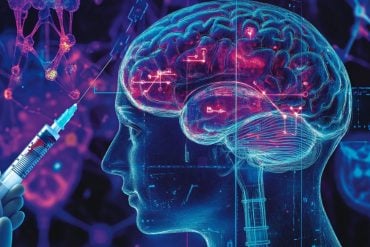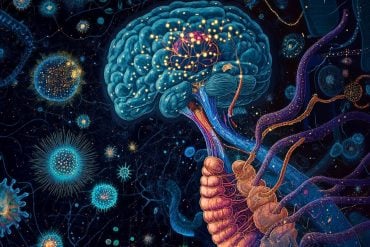Summary: New research reveals that brain cells use a muscle-like signaling mechanism to relay information over long distances. Scientists discovered that dendrites, the branch-like extensions of neurons, contain a structured network of contact sites that amplify calcium signals—similar to how muscles contract. These contact sites regulate calcium release, activating key proteins involved in learning and memory.
This mechanism explains how neurons process information received at specific points and relay it to the cell body. Understanding this process sheds light on synaptic plasticity, which underlies learning and memory formation. The findings could provide new insights into neurodegenerative diseases like Alzheimer’s.
Key Facts:
- Neural Calcium Amplification: Brain cells use structured ER contact sites to amplify calcium signals, similar to how muscle cells trigger contractions.
- Memory and Learning Connection: These calcium signals activate CaMKII, a protein critical for strengthening neuronal connections and memory formation.
- Potential Disease Insights: Understanding this mechanism could help explain cognitive dysfunction in conditions like Alzheimer’s disease.
Source: HHMI
Our biceps and our brain cells may have more in common than previously thought.
New research led by the Lippincott-Schwartz Lab shows that a network of subcellular structures similar to those responsible for propagating molecular signals that make muscles contract are also responsible for transmitting signals in the brain that may facilitate learning and memory.

“Einstein said that when he uses his brain, it is like he is using a muscle, and in that respect, there is some parallel here,” says Janelia Senior Group Leader Jennifer Lippincott-Schwartz.
“The same machinery is operating in both cases but with different readouts.”
The first clue about the possible connection between brain and muscle cells came when Janelia scientists noticed something strange about the endoplasmic reticulum, or ER – the membranous sheets and folds inside cells that are crucial for many cellular functions.
Lorena Benedetti, a research scientist in the Lippincott-Schwartz Lab, was tracking molecules at high resolution along the surface of the ER in mammalian neurons when she saw that the molecules were tracing a repeating, ladder-like pattern along the entire length of the dendrites — the branch-like extensions on brain cells that receive incoming signals.
Around the same time, Senior Group Leader Stephan Saalfeld alerted Lippincott-Schwartz to high-resolution 3D electron microscopy images of neurons in the fly brain where the ER was also forming regularly spaced, transversal structures.
The ER normally appears like a huge, dynamic net, so as soon as Lippincott-Schwartz saw the structures, she knew her lab needed to figure out what they were for.
“In science, structure is function,” says Lippincott-Schwartz, who also heads Janelia’s 4D Cellular Physiology research area.
“This is an unusual, beautiful structure that we are seeing throughout the whole dendrite, so we just had this feeling that it must have some important function.”
The researchers, led by Benedetti, started by looking at the only other area of the body known to have similar, ladder-like ER structures: muscle tissue.
In muscle cells, the ER and the plasma membrane – the outer membrane of the cell – meet at periodic contact sites, an arrangement controlled by a molecule called junctophilin.
Using high-resolution imaging, the researchers discovered that dendrites also contain a form of junctophilin that controls contact sites between their ER and plasma membrane.
Further, the team found that the same molecular machinery controlling calcium release at muscle cells’ contact sites — where calcium drives muscle contraction — was also present at dendrite contact sites — where calcium regulates neuronal signaling.
Because of these clues, the researchers had a hunch that the molecular machinery at the dendritic contact sites must also be important for transmitting calcium signals, which cells use to communicate.
They suspected that the contact sites along the dendrites might act like a repeater on a telegraph machine: receiving, amplifying, and propagating signals over long distances. In neurons, this could explain how signals received at specific sites on dendrites are relayed to the cell body hundreds of micrometers away.
“How that information travels over long distances and how the calcium signal gets specifically amplified was not known,” says Benedetti.
“We thought that ER could play that role, and that these regularly distributed contact sites are spatially and temporally localized amplifiers: they can receive this calcium signal, locally amplify this calcium signal, and relay this calcium signal over a distance.”
The researchers found that this process is triggered when a neuronal signal causes calcium to enter the dendrite through voltage-gated ion channel proteins, which are positioned at the contact sites. Although this initial calcium signal dissipates quickly, it triggers the release of additional calcium from the ER at the contact site.
This influx of calcium at the contact site attracts and activates a kinase called CaMKII, a protein known to be important in memory. CaMKII alters the plasma membrane’s biochemical properties, changing the strength of the signal that is passed down the plasma membrane.
This process continues from contact site to contact site all along the dendrite to the cell body, where the neuron decides how it will communicate with other neurons.
The new research reveals a novel mechanism for signal transmission in brain cells and helps answer an open question in neuroscience about how intracellular signals travel over long distances in neurons, enabling information received at specific sites on dendrites to be processed in the brain.
It also sheds light on the molecular mechanisms underlying synaptic plasticity – the strengthening or weakening of neuronal connections that enables learning and memory.
Figuring out this process at the molecular level could increase understanding of how the brain works normally and in diseases where these processes go awry, like Alzheimer’s.
“We are showing that a structure – a beautiful structure – operating at a level of subcellular organization is having a huge effect on the way the entire neuronal system is operating vis-à-vis calcium signaling,” Lippincott-Schwartz says.
“This is a great example of how, in doing science, if you see a beautiful structure, it can take you into a whole new world.”
About this learning and memory research news
Author: Nanci Bompey
Source: HHMI
Contact: Nanci Bompey – HHMI
Image: The image is credited to Neuroscience News
Original Research: Open access.
“Periodic ER-plasma membrane junctions support long-range Ca2+ signal integration in dendrites” by Jennifer Lippincott-Schwartz et al. Cell
Abstract
Periodic ER-plasma membrane junctions support long-range Ca2+ signal integration in dendrites
Neuronal dendrites must relay synaptic inputs over long distances, but the mechanisms by which activity-evoked intracellular signals propagate over macroscopic distances remain unclear.
Here, we discovered a system of periodically arranged endoplasmic reticulum-plasma membrane (ER-PM) junctions tiling the plasma membrane of dendrites at ∼1 μm intervals, interlinked by a meshwork of ER tubules patterned in a ladder-like array.
Populated with Junctophilin-linked plasma membrane voltage-gated Ca2+ channels and ER Ca2+-release channels (ryanodine receptors), ER-PM junctions are hubs for ER-PM crosstalk, fine-tuning of Ca2+ homeostasis, and local activation of the Ca2+/calmodulin-dependent protein kinase II.
Local spine stimulation activates the Ca2+ modulatory machinery, facilitating signal transmission and ryanodine-receptor-dependent Ca2+ release at ER-PM junctions over 20 μm away.
Thus, interconnected ER-PM junctions support signal propagation and Ca2+ release from the spine-adjacent ER.
The capacity of this subcellular architecture to modify both local and distant membrane-proximal biochemistry potentially contributes to dendritic computations.






